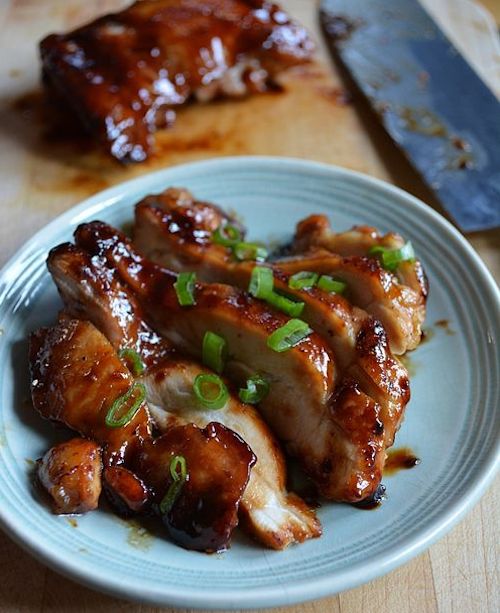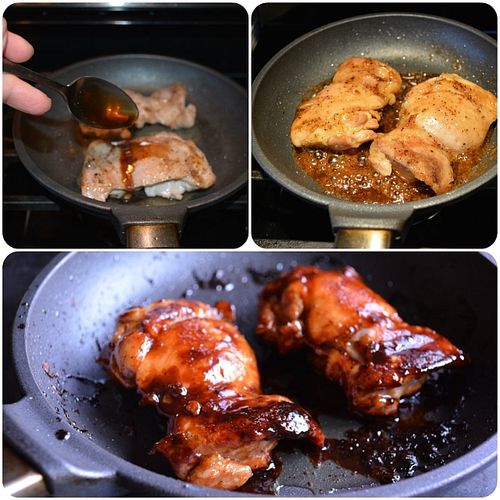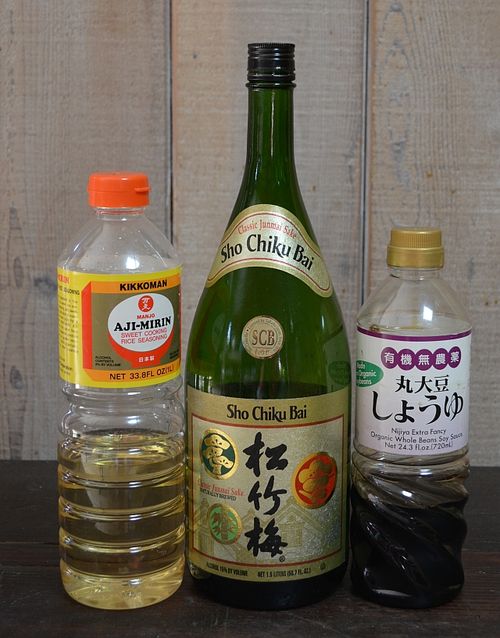
I have a friend who is a Japan and China scholar. (What an over-achieving combination, eh?) One time she invited us to her home and served what she called chicken teriyaki – it was cooked in a skillet, just the way she learned to do it in Japan, she said. I was incredulous because it wasn’t like the versions I’d eaten at Japanese restaurants in the United States. Those renditions, which I considered definitive, where grilled and brushed with a sticky sweet brown sauce.
I shelved that experience for years until last week, when I suddenly had a hankering for chicken teriyaki. Maybe it was because I’d made the batch of pickled ginger that I had Japanese food on my mind, which wandered to what I figured was an iconic dish of Japanese cuisine. I learned some interesting things.
Teriyaki Popularity Reality
One, teriyaki is not as popular in Japan as it is outside of Japan, according to my friend Hiroko Shimbo in her amazing book, The Japanese Kitchen. I am okay with that because chicken teriyaki probably sold well with Japanese restaurant owners outside of Japan. Call it the kung pao chicken syndrome. Moreover, she explains that “teri” means gloss and “yaki” means to broil or grill. Made from mirin, sake, soy sauce and sometimes sugar, teriyaki sauce is a finishing sauce meant to glaze. That made sense but why cook it in a skillet?
Shizuo Tsuji went into further details in Japanese Cooking: “Many foods that are grilled also can be pan-broiled over high heat in their own fat or with a film of oil in the pan, or quickly browned and sauteed. Since the use of a pan or grilled also is defined by the verb yaki, such cooking is part of the wide yakimono (“grilled things”) category.
So it’s a language thing. Tsuji goes on to say that while cooking over charcoal is the orthodox Japanese approach, a pan is often employed, even though it’s a stepchild kind of technique. He notes that certain things are cooked in a skillet only. While neither Tsuji or Shimbo say so, both of their recipes for chicken teriyaki call for cooking in a skillet, then finishing the chicken with the sauce to coat it with color and flavor.

Stovetop vs Grilled Teriyaki Chicken
I tried it out and there was a nice chicken flavor in the meat that was cooked in a skillet; the chicken juices were recooked into the flesh. The color is gorgeous. I cooked two thighs but call for four in the recipe below to scale the recipe up for a regular-size family.
For fun, we tried grilling the chicken with the skin on and brushing on the teriyaki sauce at the end like a glaze. My husband liked it grilled, I liked it cooked in the skillet. We ate most of it up. Try both out and make up your own mind. Either way, make the teriyaki sauce yourself. It’s ridiculously easy.
Chicken Teriyaki
Ingredients
- ½ cup mirin, storebought or homemade (see link below)
- ¼ cup sake
- ¼ cup Japanese soy sauce or regular soy sauce (such as kikkoman)
- 2 tablespoons sugar
- 4 large boneless skinless chicken thighs
- Kosher salt
- Black pepper
- Canola oil
- 1 green onion, green part only, cut into rings and/or ground sansho pepper
Instructions
- Combine the mirin and sake in a small saucepan. Heat over medium-low for 5 minutes, then add the soy sauce and sugar. Stir until dissolved. Adjust the heat to simmer for 20 to 25 minutes, until reduced by about a third and thickened. There should be a very generous ½ cup. Set aside to cool and concentrate. Use or store in a jar in the fridge for a week. Return to room temperature before using.
- Rinse and pat the thighs dry with paper towel. Poke it with a toothpick or fork to let flavors penetrate. Sprinkle with salt and pepper. Heat a medium skillet over medium heat. Add a small splash of oil. Cook the thighs, smooth side down, for 3 minutes, or until a little golden underneath. Turn each piece over, lower the heat to medium-low or low, then cover; you want a gently hiss. Cook for 8 minutes, or until just cooked through.
- Add about 2 tablespoons of the sauce. Turn to coat the chicken, increase the heat to medium. Let the chicken cook in the bubbling sauce for 3 to 5 minutes, turning often, until the sauce has coated the chicken with a reddish-brown gloss. The pan will be have some fat from the chicken as well as the cooked down dark-colored teriyaki sauce.
- Transfer the chicken to a plate and let cool for 5 to 10 minutes. Cut across the grain, arrange on a plate and garnish with a sprinkling of green onion and/or sansho pepper. Serve with rice.
Notes
Do you have a favorite way of making chicken teriyaki? In a skillet or on the grill? What kind of teriyaki sauce? Maybe I've been in the dark for too long about this.



















FreeRangeNan says
I'm surprised to see the photo of "Aji-Mirin" which is basically seasoned glucose syrup. Please try to find true mirin, which is brewed from rice, water, and koji yeast. It has about 12-13% alcohol.
I know the cheap substitute is common even in Japan, but the real thing is so much better! I'm fortunate to live in Honolulu, where I easily find true mirin at several Japanese stores, but it would be worth checking where you live. Kikkoman and Takara Masamune are two brands available here.
Mirin isn't something you'd want to drink on its own, but it brings a subtle, complex sweetness and umami to Japanese cooking.
Jon says
Nice recipe. I've made teriyaki this way with both chicken and beef (rib eye or new york strip steak), sometimes in a cast iron pan, other times in a high carbon steel pan. And Shizuo Tsuji's book is quite a read on its own, even if not used as a cookbook. Fascinating insight. I enjoy your blog, all the best!
Laura says
This looks delicious! I have a question about the pan you're using to cook the chicken. Is it nonstick? I've been looking for a safe nonstick pan and haven't found one yet. Thanks!
Vivian says
I've been looking for a good salmon teriyaki recipe. Does this recipe transfer well to fish? How long would you cook the salmon for? Thanks!
Tamaso says
I've cooked salmon similarly-- The main way I would vary this is to start the salmon skin down at medium high/high heat to crisp the skin, then add the sauce and brush/baste the fish with it, turning the pan down to low and cover. Hard to say an exact cooking time, but it will cook VERY quickly. A nice test for fish is to insert a thin knife tip into the center of the fish and leave it there for a few seconds... If the knife tip is cold, fish is not cooked, if luke-warm, it is just right; if hot, the fish may be overcooked. Enjoy!
Vivian says
Thank you Tamaso. I will give it a try.
Robert Stein says
I've often cooked fish teriyaki in a skillet this way, but with a slightly different mix for the sauce: equal parts mirin, sake, and soy with a very little bit of added sugar. I make the sauce by putting all the ingredients in a small saucepan and bringing them just to the boil until the sugar disolves. I cook the fish--I like mahi-mahi, Spanish mackerel, or any other flavorful fillet--in the usual way, starting skin-side down in a very hot pan with a little bit of oil. When the fish is done I remove the oil from the pan, then pour in the sauce over rather high heat and turn the fish to glaze it nicely. It is much more delicious than any teriyaki I've had in NYC Japanese restaurants.
Gina says
Another mouth-watering recipe... thank you!
Re Mirin: I bought the stuff shown in the photo and now I realize it's mainly glucose and it was outrageously expensive.
Can you make your own mirin?
grieg says
You are making me hungry....mmmm
Just some thought, do not use anything with glucose or fructose in it, google
for the facts, also why do you and so many sites recommend Jew approved salt as opposed
to natural sea salt or Himalayan salt full of minerals, or anything else?
Thanks Andrea
Valerie says
That was very helpful. I couldn't find true mirin at my local grocery store. But I can order from Takana directly. What is a true soy sauce brand you use?
Andrea Nguyen says
Very good point. I totally agree but alas, this is the typical stuff that people use. True mirin can be pricey and hard to find. Adding sake makes up for the difference a tad.
Andrea Nguyen says
Thanks Jon. Tsuji's books is amazingly thorough. That's why it's a classic.
Andrea Nguyen says
The skillet I used was a Swiss Diamond. It's cast iron that's been coated. I get them for a good price here:
http://www.cookwarenmore.com/
Andrea Nguyen says
Thank you Tamaso!
Andrea Nguyen says
I was thinking of using this on fish next. Yellowtail is traditional. Thanks for the tip!
Andrea Nguyen says
I totally agree with the price of mirin. Let me try to trace down a DIY sub.
Andrea Nguyen says
Grieg, I assume that the "Jew approved salt" you refer to is kosher salt? It's milder in flavor than regular salt due to the larger flakes and ever so slightly sweet. I keep many kinds of salt in my kitchen and switch back and forth. Here, the kosher salt seems to work better.
Andrea Nguyen says
Just answered your provocative question with this post:
http://www.vietworldkitchen.com/blog/2013/09/homemade-mirin-recipe.html
Thanks, Gina.
Michelle says
Takara makes real mirin with about a 12% alcohol content 🙂 IIRC I paid about $9 for a 750ml bottle at 99 Ranch. It was more than the the Kikkoman "aji" mirin but but well worth it.
plus.google.com/101925157135206405668 says
Many, if not most places in America that claim "authentic ethnic food," are anything but. Thankfully that's changing. I didn't see one person eat teriyaki in japan lol.
Mexican, Thai, Chinese, Japanese, etc etc.
If your local supermarket is a Walmart in the middle of say pig farming country Carolina.... Good luck finding quality foreign ingredients.... And authentic restaurants..... In town at least.
neena says
I've been able to find mirin at liquor stores for a similar price I would be paying for aji mirin at a local asian foods store. Also, I'm pretty partial to Kikoman soy sauce because I'm really only willing to buy one kind so that's the easiest to use all around.
Karimala1 says
Mmmmmmmm. This recipe is the BOMB!!! I tripled the recipe for the sauce and then canned most of it for 10 minutes in pint-size jars in a water bath.
taojones says
having worked in a sushi bar in LA there teriyaki sauce was made with ½ mirim 1/2 soy sauce and a bout a cup of each and a bout a tablespoon of corn starch mixed in while cold bring it to a full boil and let it cool and your golden it is sweet and salty miring mixed 50/50 with rice vinegar was also a dressing for sewed sapid and cucumber salad
tempura batter was ½ flour and ½ corn starch and enough water to make it like a thin pancake batter.
what i learned there was for great Japanese flavor the less elaborate your recipe the better it works.
taojones says
oops my autocorrect got me good that dressing is seaweed salad and that is a cup of each ingredient but to not waste miring i often use ½ cup of each and a teaspoon of cornstarch if you need to thicken more ad a small amount of both ingredients together with a bit more cornstarch cold and add it in slowly it has to come to a full boil to thicken you will see the color change from cloudy to dark brown.
Andrea Nguyen says
Thank you for the recipes!
Mark says
I followed the recipe explicitly, but my sauce was so thick and "stringy", it was almost like taffy. I have no idea what I did wrong.
Andrea Nguyen says
Thin it out with water. You likely cooked it for too long.